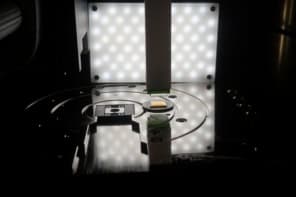Graphene and negative refractive-index materials are two of the hottest topics in physics -- but one might not think they have much in common. Now, however, physicists in the UK and US have proposed that graphene could be used to make a tiny lens to focus electrons through negative refraction. Although the lens has not yet been made, it could someday be used to focus electrons with much more precision than existing electron lenses (Science 315 5816 ).

The lens has been dreamt up by Vadim Cheianov and Vladimir Fal’ko of Lancaster University in the UK and Boris Altshuler of Columbia University in the US. It would consist of two flat metal electrodes placed side-by-side and just above (but not touching) a strip of graphene, which is a sheet of carbon atoms just one atom thick.
One electrode would have a positive voltage and attract electrons to the region of graphene below it, while the other electrode would have a negative voltage and repel electrons from the region of graphene below it. In other words, the graphene now has a p-type and an n-type region with a well defined “pn junction” in the area between the two electrodes.
The researchers then calculated what would happen to a point source of electrons in the n-type region. According to the team, electrons travelling towards the junction at an angle theta to the normal would be bent back beyond the normal by that angle — exactly what happens to light when it enters a material with negative refractive index. Indeed, electrons emanating from a point source in the n side should be focused back to a point on the p side (see figure). Simulations carried out by the researchers suggest that such a lens could have a focal length of about one micrometre.
This strange behaviour arises from graphene’s peculiar band structure, which is due to the carbon atoms being arranged in a honeycomb structure. According to the team, the negative refraction is caused by the electrons moving from the conduction to the valence band of graphene, which leads to the component of momentum that is parallel to the junction being reversed.
Unfortunately, the lenses would have some drawbacks. Only those electrons that cross perpendicular to the junction enjoy 100% transmission. This loss of electrons at the junction means that these devices could not be used to create “perfect” lenses that focus electrons to a spot smaller than the electron’s intrinsic wavelength – something that is in principle possible with negative refraction materials.
The lenses are also expected to produce “fuzzy” images because the pn junction is not sharp, but rather a gradual shift from n to p. In addition, the lens would operate best at very low temperatures, because thermal fluctuations will distort the image.
Boris Altshuler told Physics Web that building the lens would also be a challenge. Most electrons would need to travel the entire length of the lens without scattering, something that cannot be achieved in current graphene samples. In addition, little is known about how to create pn junctions that are transparent to electrons. While Altshuler is not aware of any researchers who are currently building such lenses, he says that the expertise currently exists in at least five different laboratories worldwide.



